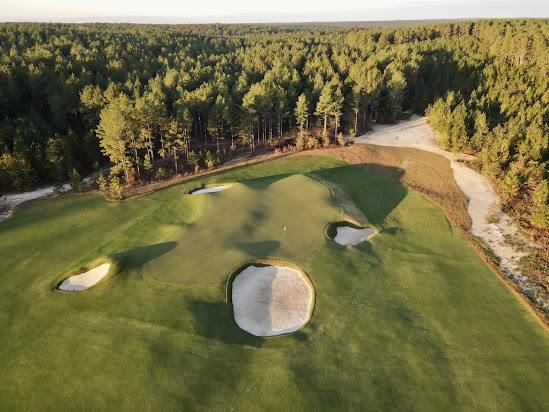It began with a dream. A desire to build a world-class golf course inspired by the best heathland courses in England. And then, the discovery of an out-of-the-way site chocked with skinny towering pines reaching for the sunlight. Beneath the pines another discovery: the perfect rolling terrain and sandy soil reminiscent of the revered Swinley Forest Golf Club. Great golf was a part of the vision, but not the full dream. The final element was creating a club that was a vehicle for good rather than simply a destination for investment bankers and tech bros. If you're going to dream, dream big. The result is Old Barnwell. A little corner of the South sprinkled with magic.
In the last two years Aiken, South Carolina has become a hot golf destination. Many golfers are familiar with the attractions of the Palmetto State's quality golf scene, although, primarily they are courses located in the Lowcountry or along marshes, rivers, or the ocean: Yeamans Hall, Harbour Town, Secession, Kiawah, Congaree, Caledonia, and Chechessee Creek. Aiken, located across the Savannah River from the Augusta area, has always had good golf: Palmetto Golf Club, dating from 1896, with an Alister Mackenzie pedigree; and Sage Valley, a popular destination during Masters week. Old Barnwell is a noteworthy new addition to the neighborhood. The course opened in 2023, along with another highly acclaimed course nearby, the Tree Farm.
Aiken, especially the old town, is a charming Southern city, surrounded by cotton fields, rolling hills, and horse farms. Aiken, along with Kentucky, Saratoga Springs and parts of Florida, are among the East Coast cities well-known by those in the equine world. Even the street signs in Aiken tout the horse culture and have silhouettes of horse heads on them. (Godfather fans, I know what you're thinking, but that's not the idea.)
Old Barnwell is situated in the Sandhills region that stretches from North Carolina through the middle of South Carolina and into Georgia. Sandy rolling hills equals good golf. If the course is designed the right way. And Old Barnwell is. My initial impressions after playing Old Barnwell are:
1. It is a great golf course on a great piece of golfing land
2. The course starts easy, is a brute during the middle stretch of holes, and then has a fun and less demanding set of finishing holes
3. Putting from off the greens is almost always the better play than chipping, since the course plays fast and firm
4. Blind shots make for interesting golf, and the architects did a good job of sprinkling in blind shots around the course
5. It is not a bomb-with-driver and then wedge-to-the-green course; you need to think your way around and pick the right angles off the tee and into the greens.
6. The 14th is an all-world, risk-reward sub-300-yard par 4. Wow.
Their website describes the club as being, "Nestled on 575 acres of sandy soil and rolling hills surrounded by towering longleaf and loblolly pines, Old Barnwell is a private national club." The course was designed by Brian Schneider and Blake Conant, who have decades of experience working with Tom Doak as part of the Renaissance Golf team, although this is their first solo effort.
The view from the clubhouse across the 18th green shows off the expansiveness of the property
While standing behind the eighteenth green, which is next to the clubhouse and first tee, most of the holes are visible across the vast expanse of land below. From this vantage point one might think that the property is relatively flat. One would be wrong. There is a lot of movement in the land, and the architects took maximum advantage of tucking fairways and greens behind the rises in the land.
Bunkering around the 1st hole
I'm a fan of a "gentle handshake" on a golf course, and Old Barnwell starts off with a relatively easy par five to ease the golfer into the round. The second is also an easy hole, a short par four of 300 yards or less, depending on your tee box. Although easy, it is best to pay close attention to what the ball does around the green, because it sets the tone for the remainder of the day. Hitting approaches into greens short is almost always better, often fifteen to twenty yards short of the putting surface, because balls tend to bounce forward on the firm turf. Golfers should also take note of how missing the undulating greens in the wrong location (sometimes over blind knobs) will shoot the ball off the green.
I always like to compare new golf courses to courses I know, and in some respects (not visually), Old Barnwell reminded me of Merion, because Merion is a thinking person's golf course. Balls must be positioned on the correct side of the fairway to allow for a favorable approach to access greens, or trouble awaits. This generalization can be used on most golf courses, but at both Merion and Old Barnwell, the penalty for not playing smart is magnified to a far larger degree than it is on most courses. That's a good thing for those who like to think their way around a golf course.
The view from the 3rd green shows off the openness of the property and also highlights the way the greens fall away if you're not smart about how to approach
The 4th green from the side
The fourth hole is the first par three, playing 165 yards. As seen above, it is a well bunkered hole. A crisp iron shot is required at precisely the right distance to avoid the menacing bunkers on the right, seen here.
Behind the 4th green is serious, serious trouble
The view above awaits the unhappy golfer who hits long on the fourth. As is the case on every hole, short is always a good play into the greens.
The 4th green
The two prior images of the fourth hole, taken from the side and from the rear, show the menacing nature of missing. This shot, taken from in front of the hole, shows how well the architects hid the hazards. They're invisible from the tee. The good news is that a shot approaching the green short finds little trouble, with a high probability of the ball bounding onto the green.
I scored well on the first four holes, but then mayhem ensued. The fifth is a 420-yard par four with a forced carry off the tee, and an elevated green that falls off sharply on the left. Bumping and running into the green is the best option. Hitting short and then putting from the firm fairway is also an excellent choice.
The 6th green falls off sharply
The sixth hole is tough but fair. It is 425 yards, and plays from an elevated tee to a wide fairway. The challenge comes from the tabletop green that falls off on all sides.
The 7th from the back tees
The seventh hole, seen above from the tee, is overly severe. As advised by my caddie, I picked the correct line off the tee (over the left bunker) but ended up in the right bunker that shoots out into the heart of the fairway. In retrospect and looking at the hole from the side and back from the green, the effective landing area for a tee shot is maybe only 20 yards wide, hugging the left edge of the fairway.
To add insult to injury, there are two deep greenside bunkers fronting the severe green, where the opening is only 15-20 yards wide. And, the green is also in the table-top style and falls off on all sides. Normally the smart play would have been to land short and have the ball run up. Unfortunately, on the day we were playing the wind was howling. That's not a figure of speech. We could literally hear the wind howling around us (sustained 15-20, gusts up to 35). Each player of my foursome attempted to land the ball short, sometimes twenty yards short, and each time it went long. Or was fed into a bunker.
The overly difficult 7th green
As seen above, the green falls away on all sides and the approach has to be precisely hit between the two bunkers. I don't think I've ever said this about a golf hole before, but perhaps the hole needs to be softened? The course is new and still in its teething stages. To ask a golfer to thread the needle that finely twice on one hole may be too much. I listened to a podcast with the course owner and he says some members lay up short of the right bunker and then hit to the green. I don't know what the prevailing wind is, but that simply wasn't an option on the day we played.
Walking off the seventh green most golfers will no doubt have bruises on them. The ground level view of the seventh doesn't do justice to the challenge at hand. The drone shot below better shows the harsh nature of the green.
The 7th green seen from a birds-eye view. Photo credit: Morgan Purvis
I was lucky enough to play Old Barnwell with my friend Paul Rudovsky. Paul has played more top 100 courses around the world than any person ever born. He has played every course on any top 100 list compiled by any magazine or website. That's any list, ever published. More than 400 top-rated courses. He loves Old Barnwell and likens it to the Old Course at St. Andrews because of the thoughtfulness required to get around it with a good score. On the seventh hole, he found two tiny areas where shots could be successfully hit into. It's too bad my ball didn't find either of those. He also found similarities to St. Andrews because Old Barnwell also has many hidden bunkers lurking to bite the unsuspecting duffer. And, if you aren't positioned correctly, approach shots turn into blind approach shots. When Paul compares a course to the Old Course it is high praise indeed. I would like to return on a day without such strong winds to see if I can place my ball in better positions.
Thus concludes a stretch of three holes, each of 420 yards+ with difficult-to-hit-and-hold-greens. But wait. There's more challenge to come.
The 8th green has a well-guarded entrance
On the card, the eighth seems like a respite hole. A 345-yard par four. The green complex is seen above. Once again, it has a tiny approach area to the green. Hit the correct line and distance and all is good. Short right is death, as is short left. Playing long, above the bunkers is a fine choice, since the ball bounds down the hill like a pinball.
Bunkering on the 12th green
The twelfth hole is the second par five on the course, and plays to an elevated green with the set of deep sand traps seen above awaiting the dreaded pulled shot. It's a pretty hole because you're up on one of the long ridges bisecting the property, and it offers wide views of the valley around it.
The 14th hole's blind/hilly approach
Fourteen is my favorite hole on the course and it is the beginning of a really good set of golf holes that take you all the way into the clubhouse. I was taught years ago to "beware of the short par four." Golf scorecards can be deceptive. 245 yards from the white tees. You're mentally thinking, alright, birdie hole! The proper shot off the tee is to the left and leaves a good approach to a green you can kinda' see. The issue with hitting and holding the shot left is that the entire fairway cants to the right, so any slight miss will see balls tumbling down the hill and will leave the approach seen above. What isn't seen is a set of deep bunkers in that swale fronting the green. The flag stick is ten feet tall to make it visible to those who hit into the valley of sin, although the putting surface is not. A well-hit short iron is demanded. I pulled off the shot, hitting exactly the right distance and line, and it was very satisfying. It's a really fun hole. My caddie said most people walk off the green with a five rather than a three. That's the mark of an excellent short par four.
An aerial view shows the challenge better. Most balls settle in the bottom of the image below. The green is seen on the back right, so the majority of golfers, whose balls settle left, have to hit over that collection of eleven bunkers. You can also see that in order to leave a tee shot in the A position requires the golfer to hit to that narrow strip of fairway about fifteen paces wide. And, the fairway slopes downward to the valley floor. A BRILLIANT HOLE!
The 14th seen from above. Photo credit: Andy Johnson
The par five 15th uphill approach
The next two holes (fifteen and sixteen) are back-to-back par fives that play to elevated greens. The fifteenth features a long wall of bunkers set at an angle to the fairway off the tee. It is a three-shot hole for all players, measuring 625 yards from the back tees, 565 from the white tees. I read that part of the inspiration for Old Barnwell's design was Woodhall Spa in England, a course that has some of the deepest bunkers in the world. I'd say they replicated parts of Woodhall Spa very well. Oh, and don't go left approaching the elevated green. As seen above, there is a cavernous penalty on the left side, with both a grass bunker and a deep sand bunker.
The sixteen hole, a 565-yarder, has a blind tee shot up an expansive hill. The land sweeps downward and to the right along the fairway, and the putting surface is a push-up green sitting on a perch atop a hill, with multiple tiers set in a little amphitheater.
The good news about Old Barnwell (aside from the seventh hole) is that the fairways are generous. Although the entire property is surrounded by tall pines, almost none come into play during the round.
The par 3 17th, with a postage stamp green
The seventeenth is a semi-blind shot of 120 yards up the hill. Misses left will receive unfavorable kicks and bound down the hill. Misses right end on top of a grassy knoll. Straight shots are good. Honestly, for a 120-yard par three with a ball on a tee the golfer should be asked to hit with precision, and the small putting surface certainly requires that.
The approach to the finishing hole with tall unruly grass above the bunkers
The grassy growth seen above the bunkers on the approach to the eighteen are a cool feature. It's too bad we don't see more of them. Visually they are a nice look. I'm obviously speaking as someone who didn't hit into them.
I can't remember a golf course where so many of the golfers in my group (myself included) putted off greens. Putts at Old Barnwell require the same exacting standards as the tee shots and the approaches. What's interesting about the greens is that when you look at them they don't look overly wild. But they are deceptive and there are many subtle places where balls hit on the wrong line just shoot off, including mysteriously, uphill putts. Despite that, we all had a blast all day long. Old Barnwell is a great place to play golf. I try not to get into the speculation business, because my prognostications are often wrong, but Paul believes Old Barnwell will easily become one of the top 100 golf courses in the world as more raters see it. I have an unusual set of friends. In a good way. I know everyone who has played the top 100 courses in the world, thus, I know more than a half-dozen people who have already played Old Barnwell, even though the course just opened and is closed during the summer season of high heat and humidity. They are a privileged, motivated group that like to chase exciting new courses before everyone else plays them. I have yet to hear a bad review of the course.
Another interesting and unique part of Old Barnwell is the approach taken by Nick Schreiber, the founder and owner. Although a private club, he wants the club to be inclusive (the birth of new oxymoron: the inclusive-private club) and used to expand the game. As such, he has set up a series of initiatives to give back to this great game we all love, including a large youth caddie program, participation in the Evans Scholarship program, working with Annika Sorenstam to help more women enter the game, and working with historically Black colleges and universities to host tournaments. Kudos to him for being so generous and having the vision to do what he has set out to do.
Another part of the club is dedicated to kids, inspired by the "wee course," in North Berwick, Scotland. There is a kids' course near the first tee, set of 25 acres, which has fifteen holes ranging in length from 75 yards to 305 yards. The flags, appropriately whimsical, are tie-dyed. One of the holes was designed by a nine-year-old as part of a design competition, and it features an elevated tee, a ramp, and two penguin bunkers. Another hole has an elevated spiral that I can't describe. For more pictures of these really interesting holes
click here. Some golf courses and country clubs tolerate kids. This place gives them a big bear hug.
The kids' course. Fun is the order of the day. Photo credit: Nick Schreiber
An image of the scorecard for the kids' course is below. Note, there are no pars listed. After completing each hole the youngster simply writes in an emoji describing how they fared on the hole: meh (sad face), better (slight smile), best (wide smile). What a groundbreaking idea. I liked it so much that I went back through the scorecard of my round on the adult course and put in meh faces next to my scores on the sixth, seventh, and eighth holes.
Although it is a private course, as is the tradition with many Aiken area courses, they open the course to the public during Masters week for $2,300 for a foursome ( $575 per person).
In addition to the world-class course already on property, there is another course planned. The Old Barnwell website explains, "The Gilroy, expected to open in 2027, will serve as a holiday course, presenting players with strategy and fun in equal measure." I love what the owner is doing here. In the same way that Mike Keiser redefined what destination resort golf could be several decades ago, Nick Schreiber is pushing boundaries and redefining what golf is and what it can be: "Old Barnwell exists to celebrate all that’s exciting, affirming, and joyful about golf, with a modern approach that serves all kind of players, families, boon companions, and connoisseurs of the game. We’re creating programs that empower, invite, and celebrate people and communities historically underrepresented in the game of golf – to create new traditions and a legacy that belong to everyone."
Old Barnwell is the first solo design by Schneider and Conant. I'd say it's the best debut since the smashing debut by David McLay Kidd at Bandon Dunes.
Well done all around.























































.jpg)



